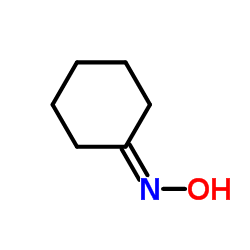环己酮肟

环己酮肟结构式

|
常用名 | 环己酮肟 | 英文名 | Cyclohexanone oxime |
|---|---|---|---|---|
| CAS号 | 100-64-1 | 分子量 | 113.158 | |
| 密度 | 1.1±0.1 g/cm3 | 沸点 | 208.0±0.0 °C at 760 mmHg | |
| 分子式 | C6H11NO | 熔点 | 86-89 °C(lit.) | |
| MSDS | 中文版 美版 | 闪点 | 112.4±8.0 °C | |
| 符号 |

GHS07 |
信号词 | Warning |
|
Oxidative effects in human erythrocytes caused by some oximes and hydroxylamine.
Arch. Toxicol. 72(5) , 270-6, (1998) Both oximes and hydroxylamine (HYAM) are compounds with known oxidative capacity. We tested in vitro whether acetaldoxime (AAO), cyclohexanone oxime (CHO), methyl ethyl ketoxime (MEKO) or HYAM affect haemoglobin oxidation (into HbFe3+), formation of thiobarbi... |
|
|
Hierarchically structured monolithic silicalite-1 consisting of crystallized nanoparticles and its performance in the Beckmann rearrangement of cyclohexanone oxime.
J. Am. Chem. Soc. 127(36) , 12595-600, (2005) In this study, we present a synthetic pathway for the fabrication of self-supporting zeolite monoliths consisting of crystallized nanoparticles. A resorcinol-formaldehyde-based organic aerogel is used as a template, and silicalite-1 is used as the zeolite exa... |
|
|
Oximes: metabolic activation and structure-allergenic activity relationships.
J. Med. Chem. 51 , 2541-50, (2008) Metabolic activation of chemicals (prohaptens) in the skin can cause allergic contact dermatitis. We have explored structure-allergenic activity relationships for seven potential oxime prohaptens using the local lymph node assay and a GSH trapping screen with... |
|
|
Toxicity of cyclohexanone oxime. I. Hematotoxicity following subacute exposure in rats.
Fundam. Appl. Toxicol. 5(1) , 117-27, (1985) Cyclohexanone oxime (CHO) was given po to male and female Fischer 344 rats at dose levels of 10, 25, 75, 150, and 300 mg/kg, five times a week for a period of 2 weeks. Control animals received distilled water. All animals given intermediate dose levels (10, 2... |
|
|
Spectroscopic (infrared, Raman, UV and NMR) analysis, Gaussian hybrid computational investigation (MEP maps/HOMO and LUMO) on cyclohexanone oxime.
Spectrochim. Acta. A. Mol. Biomol. Spectrosc. 96 , 207-20, (2012) In the present analysis, FT-IR/FT-Raman spectra of the cyclohexanone oxime (CHO, C(6)H(11)NO) are recorded. The observed vibrational frequencies are assigned and the computational calculations are carried out by HF and DFT (B3LYP and B3PW91) methods with 6-31... |
|
|
Reusable task-specific ionic liquids for a clean ε-caprolactam synthesis under mild conditions.
ChemSusChem 3(12) , 1403-8, (2010) Brønsted-acidic ionic liquids that bear a sulfonic acid group, known as Forbes acids, show a good catalytic activity for the Beckmann rearrangement, used to prepare ε-caprolactam, which is a precursor of Nylon 6. The activity essentially stems from the acidit... |
|
|
Toxicity of cyclohexanone oxime. II. Acute dermal and subchronic oral studies.
Fundam. Appl. Toxicol. 5(1) , 128-36, (1985) Dermal exposure of rabbits to cyclohexanone oxime (CHO) for 24 hr at 0, 0.8, 2, and 5 g/kg caused dose-related reticulocytosis on the day after dosing as well as a decrease in hemoglobin in the 5-g/kg females 7 days postdosing. Gavage of rats 5 days a week fo... |
|
|
Metabolism and disposition of cyclohexanone oxime in male F-344 rats.
Drug Metab. Dispos. 19(6) , 1101-7, (1991) Cyclohexanone oxime (CHOX), an intermediate used in the synthesis of Polycaprolactam/Nylon, was found to be rapidly absorbed and cleared from the body within 24 hours after a single oral administration of 1, 10 and 30 mg/kg of [14C]-CHOX to the adult male Fis... |
|
|
In vivo production of nitric oxide after administration of cyclohexanone oxime.
Chem. Res. Toxicol. 12(10) , 952-7, (1999) Cyclohexanone oxime (CHOX), an intermediate used in the synthesis of polycaprolactam (Nylon-6), has been reported to be hematotoxic in Fischer rats. The in vivo metabolism of CHOX was found to release nitric oxide, which was detected in venous blood by electr... |
|
|
Analysis of rat bone marrow by flow cytometry following in vivo exposure to cyclohexanone oxime or daunomycin HCl.
Toxicol. Appl. Pharmacol. 185(1) , 48-54, (2002) The purpose of these studies was to evaluate bone marrow from male CD rats following exposure to known hematotoxins using flow cytometry (FC) and a monoclonal antibody to the cell surface antigen CD71. Rats were treated with either CHO (300 mg/kg for 10 days)... |